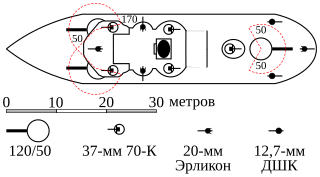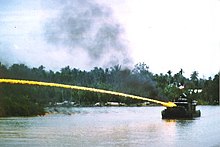
A monitor is a relatively small warship that is neither fast nor strongly armored but carries disproportionately large guns. They were used by some navies from the 1860s, during the First World War and with limited use in the Second World War.

A gunboat is a naval watercraft designed for the express purpose of carrying one or more guns to bombard coastal targets, as opposed to those military craft designed for naval warfare, or for ferrying troops or supplies.

The Romanian Naval Forces is the principal naval branch of the Romanian Armed Forces and operates in the Black Sea and on the Danube. It traces its history back to 1860.
The Royal Romanian Navy during World War I (1914–1918) was divided into two fleets and fought against the forces of the Central Powers. When Romania entered the war in August 1916, the Romanian Navy was officially divided as follows :

SMS Kaiserin und Königin Maria Theresia was an armored cruiser used by the imperial Austro-Hungarian Navy from 1895 to 1917; she was the first ship of that type built by the Austro-Hungarian Navy. The ship was a unique design, built by the Stabilimento Tecnico Triestino shipyard in Trieste; she was laid down in July 1891, launched in April 1893, and completed in November 1894. Armed with a main battery of two 24-centimeter (9.4 in) guns and eight 15 cm (5.9 in) guns, the ship provided the basis for two subsequent armored cruiser designs for the Austro-Hungarian Navy.

The Rhein class of ironclad riverine monitors (Flußkanonenboote) were a pair of ships built by the German Imperial Navy in the aftermath of the Franco-Prussian War. The class comprised two ships, Rhein and Mosel; both were built by the AG Weser shipyard in Bremen, in 1872–1874. They were armed with a pair of 12 cm (4.7 in) bronze cannon in a revolving gun turret. The ships were intended to protect the German border with France in the event of a conflict, but had short service lives, as war did not come. They served briefly in the defenses of Coblenz, starting in 1875, before being withdrawn from service. The two ships were sold for scrap, apparently in December 1884.

SMS Leitha or Lajta Monitor Museumship was the first river monitor in Europe and the oldest and also the only remaining, fully restored warship of the Austro-Hungarian Navy. Currently it is moored on the Danube in Budapest near the Hungarian Parliament Building as a museum ship.

The Yugoslav monitor Drava was a river monitor operated by the Royal Yugoslav Navy between 1921 and 1941. She was originally built for the Austro-Hungarian Navy as the name ship of the Enns-class river monitors. As SMS Enns, she was part of the Danube Flotilla during World War I, and fought against the Serbian and Romanian armies from Belgrade to the lower Danube. In October 1915, she was covering an amphibious assault on Belgrade when she was holed below the waterline by a direct hit, and had to be towed to Budapest for repairs. After brief service with the Hungarian People's Republic at the end of the war, she was transferred to the newly created Kingdom of Serbs, Croats and Slovenes, and renamed Drava. She remained in service throughout the interwar period, but was not always in full commission due to budget restrictions.

The Yugoslav monitor Sava is a Temes-class river monitor that was built for the Austro-Hungarian Navy as SMS Bodrog. She fired the first shots of World War I just after 01:00 on 29 July 1914, when she and two other monitors shelled Serbian defences near Belgrade. She was part of the Danube Flotilla, and fought the Serbian and Romanian armies from Belgrade to the mouth of the Danube. In the closing stages of the war, she was the last monitor to withdraw towards Budapest, but was captured by the Serbs when she grounded on a sandbank downstream from Belgrade. After the war, she was transferred to the newly created Kingdom of Serbs, Croats and Slovenes, and renamed Sava. She remained in service throughout the interwar period, although budget restrictions meant she was not always in full commission.

Vardar was a Sava-class river monitor built for the Austro-Hungarian Navy as SMS Bosna, but was renamed SMS Temes (II) before she went into service. During World War I, she was the flagship of the Danube Flotilla, and fought the Serbian Army, the Romanian Navy and Army, and the French Army. She reverted to the name Bosna in May 1917, after the original SMS Temes was raised and returned to service. After brief service with the Hungarian People's Republic at the end of the war, she was transferred to the newly created Kingdom of Serbs, Croats and Slovenes, and renamed Vardar. She remained in service throughout the interwar period, although budget restrictions meant she was not always in full commission.

SMS Körös was the name ship of the Körös-class river monitors built for the Austro-Hungarian Navy. Completed in 1892, the ship was part of the Danube Flotilla, and fought various Allied forces from Belgrade down the Danube to the Black Sea during World War I. After brief service with the Hungarian People's Republic at the end of the war, she was transferred to the newly created Kingdom of Serbs, Croats, and Slovenes, and renamed Morava. She remained in service throughout the interwar period, although budget restrictions meant she was not always in full commission.

The Sava-class river monitors were built for the Austro-Hungarian Navy during the mid-1910s. The two ships of the class were assigned to the Danube Flotilla and participated in World War I. The ships survived the war and were transferred to Romania and the newly created Kingdom of Serbs, Croats and Slovenes as reparations.

The Enns-class river monitors were built for the Austro-Hungarian Navy during the mid-1910s. The two ships of the class were assigned to the Danube Flotilla and participated in World War I. The ships survived the war and were transferred to Romania and the newly created Kingdom of Serbs, Croats and Slovenes as reparations.
The Dnieper Flotilla is the name given to the various naval flotillas on the Dnieper River. These were particularly active in four conflicts: the Russo-Turkish wars of 1735–39 and 1787–92, the Russian Civil War, and World War II.

The Czechoslovak Naval Forces were the naval arm of the former Czechoslovak state. Czechoslovakia being landlocked and with no large rivers flowing through it, its naval forces were small and consisted only of riverine craft operating on the Danube.

The Brătianu-class river monitors were a class of four river monitors used by the Romanian Navy. They were named Ion C. Brătianu, Lascăr Catargiu, Mihail Kogălniceanu and Alexandru Lahovari.

NMS Mihail Kogălniceanu was a Brătianu-class river monitor of the Romanian Navy. She saw service in both world wars, being the most successful vessel in her class of four ships. Like her three sisters, she was initially built as a river monitor, but in early 1918, she was converted to a sea-going monitor. During the Second Balkan War, she supported the Romanian crossing of the Danube into Bulgaria. During World War I, she carried out numerous bombardments against the Central Powers forces advancing along the shore of the Danube and carried out the last action of the Romanian Navy before the 11 November 1918 armistice. She later fought successfully against Bolshevik naval forces during the early months of the Russian Civil War, helping secure the Budjak region. During the interwar period, she contributed to the suppression of the Tatarbunary Uprising and was rearmed with longer main guns towards the end of the 1930s. During World War II, she fought several engagements against the Soviet Navy in the first month of the Eastern Front, but was ultimately sunk by Soviet aircraft shortly after Romania ceased hostilities against the Soviet Union, on 24 August 1944.

The action of 26 June 1941 consisted in an engagement between the navies of the Soviet Union and the Kingdom of Romania, taking place on the Chilia branch of the Danube Delta, near the commune of Ceatalchioi. The action resulted in a Romanian victory and the withdrawal of the Soviet vessels, one of them being damaged and later captured.
The Romanian Danube Flotilla is the oldest extant naval force on the Danube, dating since 1860, when the Romanian Navy was founded. It saw service during most of the wars involving Romania, and was the most powerful river naval force in the world during the Interwar period.





















